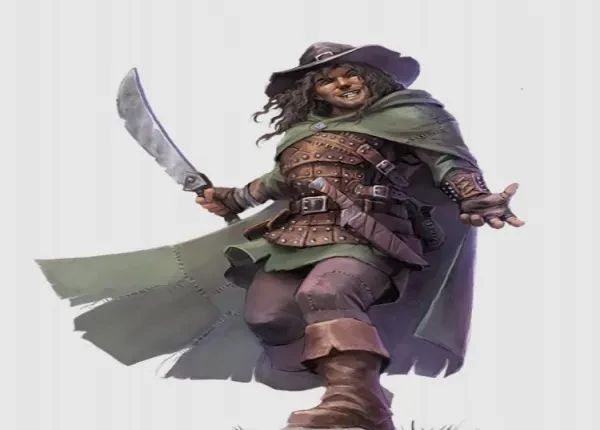
While there are a lot of monsters and demons in the Pathfinder world, the party is just as likely to come into conflict with humans. Some are as monstrous as the monsters themselves. Others have chosen a life of crime. And sometimes, an impasse has been reached and a fight between two groups of good people is inevitable.
15. Bandits
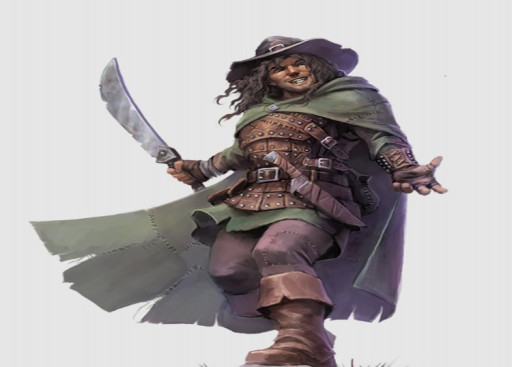
Often shutting down trade routes or taking over towns outright, bandits are among the first types of enemies Pathfinders face. Usually relying on threats and intimidation, bandits can torment the general population. Equally armed adventurers are another matter.
Bandits often attack in numbers and often by ambushing the party. They can potentially demoralize a party member if they use this attack. This will hamper their ability to fight.
While not particularly fearsome, bandits are a good choice for a first combat. These can help players understand the combat system and help get the story moving. Many NPCs that give out main quests wait until after the party proves itself in a hunting bandits/goblins tutorial quest.
Bandit Stats
- Level 2
- Perception +6
- Languages Common
- Skills Athletics +6, Deception +5, Forest Lore +4, Intimidation +6, Stealth +8, Survival +6, Thievery +8
- Str +3, Dex +3, Con +1, Int +0, Wis +2, Cha +1
- Items hatchet, sling (10 bullets), studded leather armor
- AC 19; Fort +7, Ref +9, Will +6
- HP 30
- Bandit's Ambush When the bandit rolls initiative using Deception or Stealth, they can attempt to Demoralize one creature as a free action.
- Speed 25 feet
- Melee hatchet +9 [+5/+1] (agile, sweep), Damage 1d6+5 slashing
- Ranged sling +9 [+4/-1] (propulsive, range increment 50 feet, reload 1), Damage 1d6+3 bludgeoning
- Ranged hatchet +9 [+5/+1] (agile, sweep, thrown 10 feet), Damage 1d6+5 slashing
- Dread Striker Frightened creatures are flat-footed to the bandit.
- Favored Terrain The bandit ignores the effects of non-magical difficult terrain in forests.
14. The Drunkard
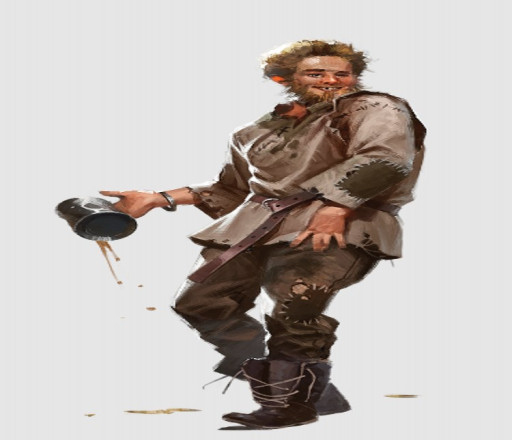
Every tavern has at least one guy who doesn’t know how to handle his booze. Most times, they’ll just act stupid. But sometimes they can become a problem for a group of new Pathfinders on a timed mission.
Generally, drunkards aren’t a direct threat unless they’ve become magically enhanced. They can’t hit hard, even in rage mode, and they only have their tankard for a ranged weapon. The big issue is that drunkards have the law on their side. Pathfinders are limited in what they can do even if the drunk is being an obstacle while someone is escaping.
GMs and scenario writers will sometimes use the drunk as an impediment during a chase scenario. The barbarian can’t just chop a drunk in half because he annoyed them. So the party has to evade the drunk or subdue him in a non-lethal fashion and find their target later.
Drunkard Stats
- Level 2
- Perception +6
- Languages Common
- Skills Alcohol Lore +3, Athletics +7, Intimidation +8
- Str +3, Dex +2, Con +4, Int -1, Wis +0, Cha +2
- Items drunkard's outfit (functions as padded armor), pewter mug
- AC 17; Fort +10, Ref +8, Will +6
- HP 40
- Speed 25 feet
- Melee fist +9 [+5/+1] (agile, nonlethal), Damage 1d6+3 bludgeoning
- Ranged pewter mug +8 [+3/-2] (thrown 10 feet), Damage 1d4+3 bludgeoning
- Drunken Rage (concentrate, emotion, mental) Requirements The drunkard is drunk, and isn't fatigued or raging; Effect Something sets the drunkard off, causing them to fly into a drunken rage. They gain 6 temporary Hit Points that last until the drunken rage ends. While raging, they deal 4 additional damage with melee attacks and take a -1 penalty to AC. The drunkard can't use concentrate actions except Seek and rage actions. The rage lasts for 1 minute or until the drunkard falls unconscious or sobers up. The drunkard can't voluntarily stop the Drunken Rage. Once the rage ends, the drunkard can't Rage again for 1 minute.
13. Cultist
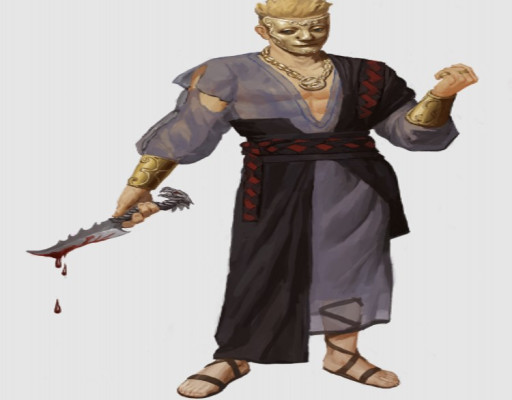
A cultist is another potential first encounter. Found throughout the game’s world, cults often worship more obscure deities. But many worship forbidden deities or even demons. The latter group tends to be the biggest problem.
Often posing a threat in large numbers, your generic cultist often uses the favored weapon of their god. Others who worship gods that emphasize poisons may use poisoned weapons. And some cultists have magic scrolls (we’re using generic cultists in the stat line).
Cultist encounters can be frantic in certain situations. Poisoning can be an area of concern for low-level parties. And some encounters can take place within a time limit. For example, the party may need to fight cultists while trying to stop a dangerous ritual.
Cultist Stats
- Level 1
- Perception +4
- Languages Common
- Skills Cult Lore +8 (applies to the cultist's own cult), Deception +3, Intimidation +3, Occultism +3, Society +4, Stealth +6
- Str +4, Dex +3, Con +2, Int +1, Wis -1, Cha +0
- Items cultist garb (functions as leather armor), dagger
- AC 17; Fort +7, Ref +8, Will +4 (or +2 vs. higher-ranking members of the cult)
- HP 20
- Speed 25 feet
- Melee dagger +7 [+3/-1] (agile, versatile S), Damage 1d4+4 piercing
- Ranged dagger +6 [+2/-2] (agile, thrown 10 feet, versatile S), Damage 1d4+4 piercing
- Fanatical Frenzy Requirements The cultist has taken damage and is neither fatigued nor already in a frenzy; Effect The cultist flies into a frenzy that lasts 1 minute. While frenzied, the cultist gains a +1 status bonus to attack rolls and a +2 status bonus to damage rolls, and they take a -2 status penalty to AC. The cultist can't voluntarily stop their frenzy. After their frenzy, the cultist is fatigued.
12. Reckless Scientist
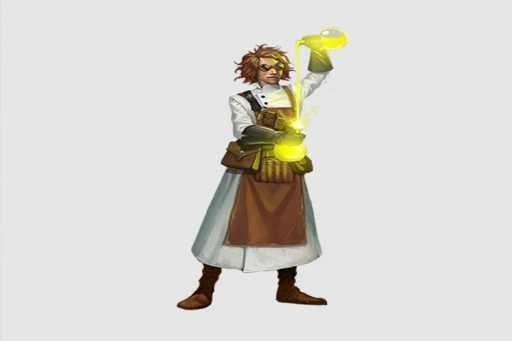
Some creatures do bad things for fun. Some do the for profit. But some do things because they believe they’ll advance the cause of science. Enter the reckless science.
A reckless scientist uses chemicals to artificially enhance themselves or animals. In battle, they like to throw bombs. Typically they use alchemist’s fires or acid flasks. The reckless science ability lets them combine bombs to make a bomb with two effects. However, failure means that it will backfire in a literal sense.
The reckless scientist makes for an exciting boss encounter. A GM can customize him and give him different bombs and ellxers. A GM who wants to try for a more challenging encounter can add mutagens to enhance his somewhat middling combat power. There’s also the possibility of adding mutated animals for added scientific villainy.
Reckless Scientist Stats
- Level 6
- Perception +10
- Languages Common
- Skills Acrobatics +12, Crafting +17, Deception +9, Engineering Lore +15, Medicine +10, Stealth +12, Underworld Lore +13
- Str +1, Dex +4, Con +5, Int +5, Wis +2, Cha -1
- Infused Items A reckless scientist carries the following infused items: 2 moderate acid flasks, 2 moderate alchemist's fires, 1 lesser bomber's eye elixir, 2 moderate frost vials, and 3 lesser elixirs of life. These items last for 24 hours, or until the next time the scientist makes their daily preparations.
- Items work coat (functions as padded armor), +1 sickle, alchemist's tools, bandolier, moderate antidote, moderate antiplague
- AC 23; Fort +17, Ref +14, Will +10; +1 status to all saves vs. poison
- HP 92; Resistances poison 5
- Unstable Compounds When an attacker scores a critical hit against the reckless scientist, one of the scientist's poorly stowed alchemical items bursts. The GM determines the item randomly. If it was a bomb, the alchemist takes damage from the bomb, and any creature adjacent to the alchemist takes the splash damage. Any other item is simply wasted.
- Speed 25 feet
- Melee sickle +17 [+13/+9] (agile, finesse, magical, trip), Damage 1d4+7 slashing
- Ranged alchemical bomb +16 [+11/+6] (range increment 20 feet, splash), Effect varies by bomb
- Quick Bomber The reckless scientist Interacts to draw a bomb, then Strikes with it.
- Reckless Alchemy (concentrate, manipulate) Requirements The reckless scientist is holding a bomb or elixir; Effect The reckless scientist combines the bomb with another bomb or the elixir with another elixir. They can Interact to draw a second bomb or elixir if necessary as part of this action. They attempt a DC 28 Crafting check, destroying both component items to create one new item. If a viable resulting item isn't used by the end of the scientist's next turn, it explodes as described under critical failure.
- Critical Success The new item has the full effect of both component items when used.
- Success The new item combines both items, but halves the effect of each. (This halves damage for bombs, the amount of healing of elixirs of life, or the duration for effects that can't have their value halved. Details are determined by the GM.)
- Failure The new item is inert.
- Critical Failure The new item immediately explodes, dealing 3d6 piercing damage to the reckless scientist.
11. Mastermind
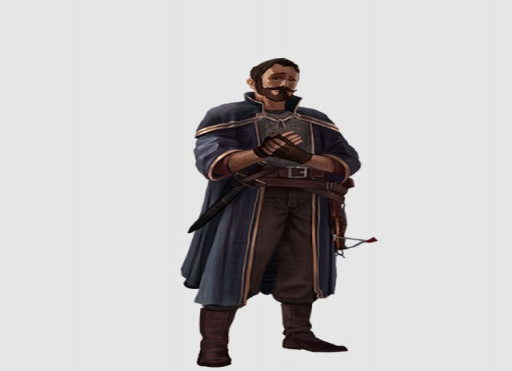
Some human villains enact their plans by force. Using physical or magical force to get what they want. Others may not have the physical or magical force needed to enact a grand evil plan. But they have a silver tongue and social capital.
This is the mastermind. They pull the strings from behind the scenes. They hire bandits and assassins to kill people. When the party reaches them, they’re in for an exciting encounter.
On the off-chance the party is facing the mastermind in a social challenge, their level will be higher. If they’re fighting a mastermind, they’re fighting someone with a decent amount of magic. They also have things like inspire courage so the party can expect a fight with a lot of amped-up minions too.
Mastermind Stats
- Level 4
- Perception +10
- Languages Common
- Skills Arcana +13, Deception +15, Diplomacy +15, Intimidation +15, Occultism +15, Performance +17, Religion +11, Society +17, Stealth +9, Thievery +9, Underworld Lore +17
- Str +0, Dex +3, Con +0, Int +4, Wis +2, Cha +4
- Versatile Performance The mastermind can use Performance instead of Diplomacy to Make an Impression and instead of Intimidation to Demoralize. The mastermind can also use an acting Performance instead of Deception to Impersonate.
- Items chain shirt, disguise kit, hand crossbow (10 bolts), shortsword
- AC 21; Fort +6, Ref +11, Will +16
- HP 54
- Speed 25 feet
- Melee shortsword +13 [+9/+5] (agile, finesse, versatile S), Damage 1d6+6 slashing
- Ranged hand crossbow +13 [+8/+3] (range increment 60 feet, reload 1), Damage 1d6+3 piercing
- Occult Spontaneous Spells DC 22, attack +14; 2nd blur, charm, invisibility, paranoia (3 slots); 1st charm, illusory disguise, illusory object (3 slots); Cantrips (2nd) daze, detect magic, message, prestidigitation, sigil
- Bard Composition Spells DC 22; Cantrips (2nd) inspire competence, inspire courage
- Scoundrel's Feint When the mastermind successfully Feints, the target is flat-footed against the mastermind's melee attacks until the end of the mastermind's next turn. On a critical success, the target is flat-footed against all melee attacks for that time, not just the mastermind's.
- Sneak Attack The mastermind deals an extra 1d6 precision damage to flat-footed creatures.
10. Burglars
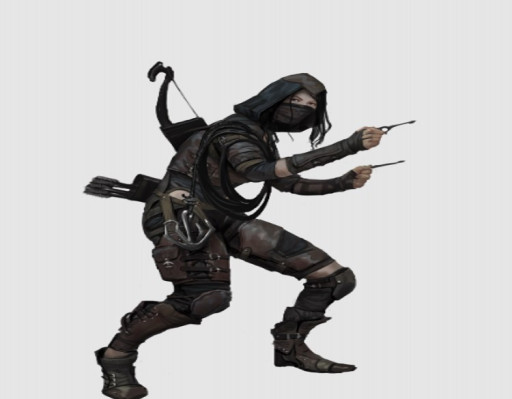
Many low-level Pathfinders often have to take guard duty jobs. Usually, this means keeping an eye on some magical trinket or making sure some noble’s stuff is safe. But for as long as people have had stuff, people have wanted to take that stuff. Enter the burglar.
Burglars have many of the same abilities rogues have. Most times they work alone but may work together on a job if the reward is big enough and they know they’ll be facing Pathfinders. Rogue players may find burglars to be tough opponents as they can deny advantage to anyone 4th level or lower, thus eliminating their sneak attack damage.
What makes this fight interesting for Pathfinders is that they’re balancing two objectives. First, they have to eliminate the burglars. With abilities like nimble dodge, this is sometimes easier said than done. Second, they have to make sure that they don’t destroy the house they’re guarding. The burglar wants the things he came for, or at least for somebody else not to have them. They’re not bound by concerns about collateral damage.
Burglar Stats
- Level 4
- Perception +10; (11 to find traps)
- Languages Common
- Skills Acrobatics +10, Athletics +8, Deception +7, Society +7, Stealth +12, Thievery +12 (can Disable traps that require master proficiency), Underworld Lore +7
- Str +2, Dex +4, Con +1, Int +1, Wis +2, Cha +1
- Items climbing kit, composite shortbow (10 arrows), leather armor, lesser darkvision elixir, sap, thieves' tools
- AC 21 (22 vs. traps); Fort +7, Ref +12, Will +10; +1 circumstance to all saves vs. traps
- HP 60
- Deny Advantage The burglar isn't flat-footed to creatures of 4th level or lower that are hidden, undetected, flanking, or using surprise attack.
- Nimble Dodge Trigger The burglar is targeted with a melee or ranged attack by an attacker it can see; Effect The burglar gains a +2 circumstance bonus to AC against the triggering attack.
- Speed 30 feet
- Melee shortsword +14 [+10/+6] (agile, finesse, versatile S), Damage 1d6+6 piercing
- Melee sap +12 [+8/+4] (agile, nonlethal), Damage 1d6+4 bludgeoning
- Ranged composite shortbow +14 [+9/+4] (deadly 1d10, propulsive, range increment 60 feet, reload 0), Damage 1d6+4 piercing
- Mobility When the burglar Strides half their Speed or less, that movement does not trigger reactions.
- Sneak Attack The burglar deals an extra 1d6 precision damage to flat-footed creatures.
- Surprise Attack On the first round of combat, if the burglar rolls Deception or Stealth for initiative, creatures that haven't acted are flat-footed to them.
9. Watch Officer
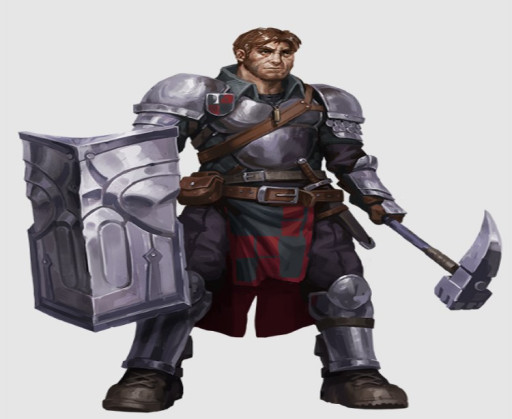
A central question in many tabletop games is whether it is better to be lawful or good. Most Pathfinders do want to see a just outcome. But unfortunately, sometimes good people have different ideas on what justice is and Pathfinders may face the wrath of the city guard.
The average watch officer group can be a problem for a low-level party. Parties that rely on fear spells to control a battlefield will have trouble scaring a watch officer. They also hit hard and with shields and armor, they’re hard to hit.
What’s more challenging is that they can call more officers. Meaning a fight with a watch officer is less of a fight and more of a “flee town before the party is completely worn down by attrition” situation. And if your party is being good, they may not want to kill anyone so they might be trying to use the minimum force needed.
Watch Officer Stats
- Level 3
- Perception +8; (9 to Sense Motive)
- Languages Common
- Skills Athletics +11, Diplomacy +6, Intimidation +9, Legal Lore +7, Society +5
- Str +4, Dex +1, Con +3, Int +0, Wis +1, Cha +1
- Items breastplate, crossbow (20 bolts), dagger, signal whistle, steel shield (Hardness 5, 20 HP, BT 10), warhammer
- AC 20 (22 with shield raised); Fort +10, Ref +6, Will +8
- HP 45
- Air of Authority (aura, emotion, mental) 10 feet. Creatures in the aura who are the same or lower level than the watch officer take a -2 status penalty to their Will DC against the watch officer's attempts to Coerce or Demoralize them.
- Bravery When the watch officer rolls a success on a Will save against a fear effect, they get a critical success instead. In addition, any time they gain the frightened condition, reduce its value by 1.
- Attack of Opportunity
- Shield Block
- Speed 25 feet
- Melee warhammer +13 [+8/+3] (shove), Damage 1d8+7 bludgeoning
- Ranged crossbow +10 [+5/+0] (range increment 120 feet, reload 1), Damage 1d8+3 piercing
- Sudden Charge Frequency once per round; Effect The watch officer Strides twice. If they end their movement within melee reach of at least one enemy, they can make a melee Strike against that enemy.
8. Bounty Hunters
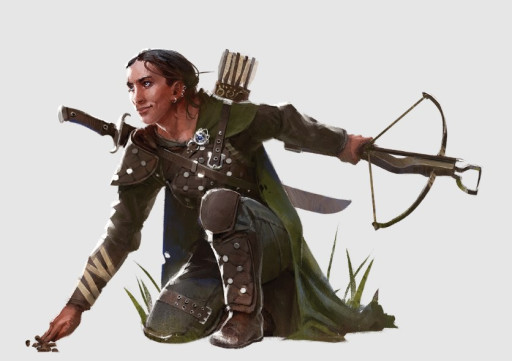
While Pathfinders often hunt down dangerous criminals, they’re just as likely to be escorting someone who is viewed as a dangerous criminal (particularly if they’re from a nation with a despotic ruler). Or at least someone who ticked off people with a lot of money. These people may hire bounty hunters.
Master trackers, bounty hunters can track people in big cities or in the wilderness. Many of them rely on ranger skills to track and attack. They often rely on stealth and attacking at night in the wilderness.
The latter part can put people who rely on heavy armor at a disadvantage since they can’t sleep in armor. It is also worth noting that the challenge level of bounty hunters can vary. We’re using a generic stat-line but anyone can be a bounty hunter.
Generic Bounty Hunter stats
- Level 4
- Perception +14
- Languages Common
- Skills Athletics +9, Deception +10, Diplomacy +8, Intimidation +8, Stealth +12, Survival +10
- Str +3, Dex +4, Con +1, Int +0, Wis +4, Cha +1
- Items crossbow (10 bolts), falchion, simple manacles, studded leather armor
- AC 21; Fort +9, Ref +12, Will +12
- HP 60
- Speed 25 feet
- Melee falchion +13 [+8/+3] (forceful, sweep), Damage 1d10+6 slashing
- Ranged crossbow +14 [+9/+4] (range increment 120 feet, reload 1), Damage 1d10+5 piercing
- Hunt Prey (concentrate) The bounty hunter designates a single creature they can see and hear, or one they're Tracking, as their prey. The bounty hunter gains a +2 circumstance bonus to Perception checks to Seek the prey and to Survival checks to Track the prey. This effect lasts until the bounty hunter uses Hunt Prey again.
- Precision Edge The first time the bounty hunter hits their hunted prey in a round, they deal an additional 1d8 precision damage.
- Running Reload The bounty hunter Stride, Steps, or Sneaks, and then Interacts to reload.
7. Necromancer
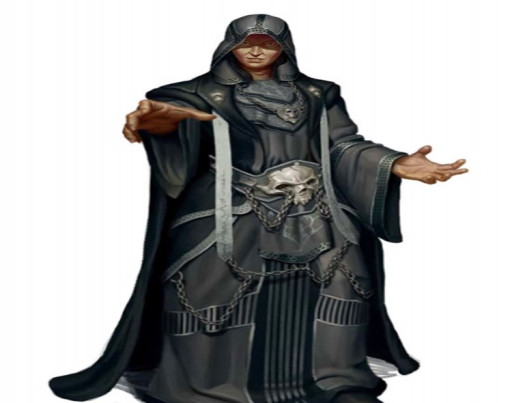
Credit: Fantasy Pics Inc.
Some people don’t want to accept that their loved ones are dead. Others think that the piles of long-dead bones can be raised into an army to destroy the city. Often attempting to perfect necromancy causes problems for whatever town the party is in and for the necromancer themselves.
Necromancers, like most mages, tend to be squishy. They can enhance their durability somewhat with spells like shield, blur and mirror image. If he has heard the party coming, he’ll likely have those cast already. He’ll also have a good chunk of undead servants ready to go.
It’s when he has that army that he’s at his most dangerous. He becomes effective artillery, slinging spells like electric arc, lightning bolt, and grim tendrils, which can target multiple party members. However, a necromancer that doesn’t know what he’s doing can be equally dangerous as a botched ritual can bring up something beyond his control.
Necromancer Stats
- Level 5
- Perception +10
- Languages Common
- Skills Arcana +13, Crafting +11, Intimidation +8, Religion +10
- Str +2, Dex +3, Con +2, Int +4, Wis +3, Cha -1
- Stench of Decay (arcane, aura, conjuration, poison) The necromancer emits a scent of putrid rot in a 5-foot emanation. A creature that enters or begins its turn in the aura is sickened 1.
- Items scroll of spectral hand, hooded robe, light mace, spellbook
- AC 20; Fort +9, Ref +12, Will +12
- HP 58
- Speed 25 feet
- Melee light mace +12 [+8/+4] (agile, finesse, shove), Damage 1d4+4 bludgeoning
- Wizard Prepared Spells DC 21, attack +13; 3rd bind undead, lightning bolt, vampiric touch; 2nd false life, grim tendrils, mirror image, web; 1st fear, feather fall, ray of enfeeblement, spider sting; Cantrips (3rd) chill touch, detect magic, electric arc, ray of frost, read aura, shield
- Wizard School Spells DC 21, 1 Focus Point; 3rd call of the grave
- Drain Bonded Item (arcane) Frequency once per day; Requirements The necromancer hasn't acted yet on this turn; Effect The necromancer expends the power stored in their mace. This gives them the ability to cast one prepared spell they prepared today and already cast, without spending a spell slot.
6. Poacher
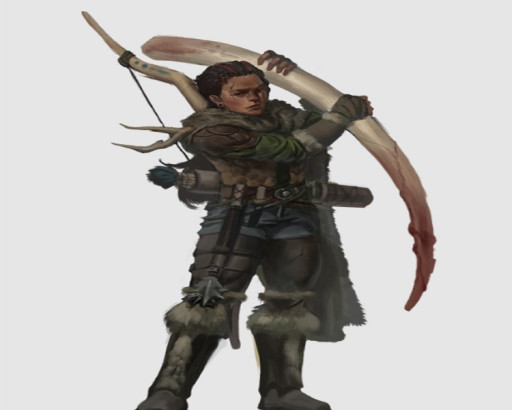
In a Pathfinder game where protecting animals is a high priority, your party is likely going to encounter a poacher. They seek to kill animals for many reasons. Sometimes, they want to get back at nobles. Other times, they want the parts as many unscrupulous mages need them for spells and don’t care how they’re obtained.
A poacher is a more malicious ranger. They’re experts with the bow and can use rough terrain to their advantage to stay out of sight. Many will hide and wait for the party to get in range. And their hunt prey ability can do a lot of damage.
A poacher encounter can be good for teaching players about terrain and stealth mechanics. Getting to a poacher who is actively firing at the party can take multiple turns. The party also has to juggle protecting the nearby animals, especially if a group of poachers are involved.
Poacher Stats
- Level 2
- Perception +9
- Languages Common
- Skills Crafting +4, Deception +4, Nature +7, Stealth +8, Survival +7
- Str +2, Dex +4, Con +1, Int +0, Wis +3, Cha +0
- Forager While using Survival to Subsist, if the hunter rolls a failure or a critical failure, they get a success instead. If the hunter rolls a success, they can provide food for 4 additional creatures that eat about as much as a human, or 8 creatures on a critical success.
- Snare Crafting The poacher can use the Crafting skill to create the following snares: alarm snare, hampering snare, marking snare, and signaling snare. The poacher can create four snares each day without paying for the materials, using 3 Interact actions to set up each snare.
- Items club, composite shortbow (20 arrows), padded armor, snare kit
- AC 19; Fort +7, Ref +10, Will +7
- HP 30
- Speed 25 feet
- Melee club +8 [+3/-2], Damage 1d6+5 bludgeoning
- Ranged composite shortbow +10 [+5/+0] (deadly 1d10, propulsive, range increment 60 feet, reload 0), Damage 1d6+3 piercing
- Hunt Prey (concentrate) The poacher designates a single creature they can see and hear, or one they're Tracking, as their prey. The poacher gains a +2 circumstance bonus to Perception checks to Seek the prey and to Survival checks to Track the prey. The first time the poacher hits the designated prey in a round, they deal an additional 1d8 precision damage. The poacher also ignores the penalty for making ranged attacks within their second range increment. These effects last until the poacher uses Hunt Prey again.
5. Captain of the Guard
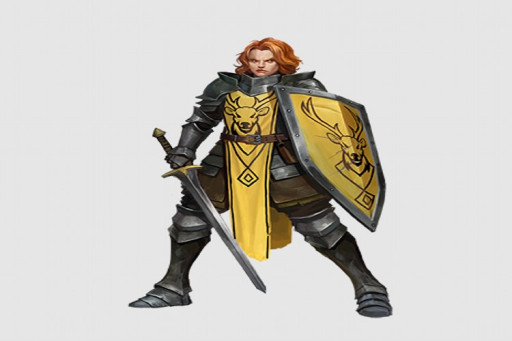
To get the position of captain, a city guard must be exceptional at all parts of his job. The captain comes with upgraded equipment, including magic weapons.
This equipment also includes armor. His shield gives him a high armor bonus. And he can use that shield to intercept attacks against his allies. And they can buff their officers and increase their ability to do damage.
Though the Captain of the Guard is a fierce opponent, particularly when paired with other lower-ranking guards, what makes him interesting is that there can be multiple ways of dealing with him. Lower-ranking guards tend to be less flexible because of their station. A Captain can potentially be reasoned with since they have enough rank to look the other way. However, that depends on the party’s actions toward the other guards before they meet him. If the party dispatches the other guards non-lethally, the Captain may be inclined to hear them out. If there’s a trail of guard corpses, he’s not going to want to hear any explanation. If the party manages to defeat the Captain of the Guard (often a popular figure unless he’s corrupt) they can expect to leave the town with only what they can carry. Sometimes the most interesting part of an encounter is the consequences.
Captain of the Guard Stats
- Level 6
- Perception +15
- Languages Common
- Skills Athletics +15, Diplomacy +11, Intimidation +13, Legal Lore +12, Society +10, Warfare Lore +8
- Str +5, Dex +0, Con +2, Int +0, Wis +3, Cha +3
- Items +1 longsword, crossbow (20 bolts), dagger, full plate, steel shield (Hardness 5, 20 HP, BT 10)
- AC 24 (26 with shield raised); Fort +14, Ref +12, Will +15
- HP 95
- Aura of Command (aura, emotion, mental) 30 feet. The captain of the guard bolsters lower-level guards under their command, granting them a +1 status bonus to their attack rolls and a +2 status bonus to their Will saves.
- Bravery When the captain of the guard rolls a success on a Will save against a fear effect, they get a critical success instead. In addition, any time they gain the frightened condition, reduce its value by 1.
- Shield Warden When the captain has their shield raised, they can Shield Block when an attack is made against an adjacent ally. If they do, the shield prevents that ally from taking damage instead of the captain.
- Attack of Opportunity
- Shield Block
- Speed 20 feet
- Melee longsword +18 [+13/+8] (magical, versatile P), Damage 1d8+11 slashing
- Ranged crossbow +12 [+7/+2] (range increment 120 feet, reload 1), Damage 1d8+6 piercing
- Shielded Advance Requirements The captain of the guard has their shield raised; Effect The captain of the guard presses forward, using their shield to push back foes. The captain Strides and Shoves, in either order. The multiple attack penalty doesn't apply to this Shove, though the Shove does count toward the captain's multiple attack penalty.
4. Demonologist
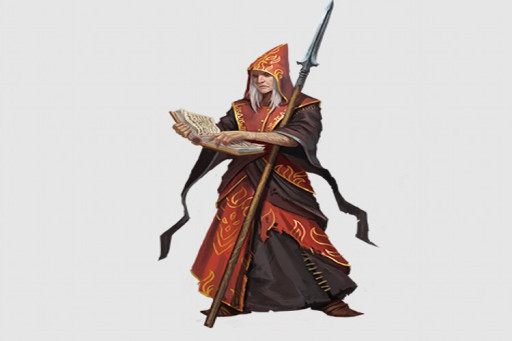
Pathfinders frequently find themselves fighting power-hungry maniacs. Their power can come from many sources. One of the most dangerous power sources is demons. The demonologist thinks he can borrow power from demons but power has a price.
That said, anyone who does make a bargain with a demon has considerable power, to begin with. They have powerful offensive and defensive spells. Many of them are area-of-effect spells like fireball.
The real problem is the demon itself. By the time a party gets to a demonologist, the demon will have already been summoned. The type of demon depends on the demonologist’s power A powerful demon may decide to dispose of the demonologist if he gets too weak.
Demonologist Stats
- Level 7
- Perception +15
- Languages Abyssal, Common
- Skills Academia Lore +14, Arcana +16, Demon Lore +18, Diplomacy +11 (+13 with demons), Religion +15
- Str +3, Dex +1, Con +2, Int +4, Wis +4, Cha +0
- Abyssal Temptation (divine, enchantment, mental) Demonic study has garnered the attention of at least one demon that is actively trying to possess the demonologist. When the demonologist publicly espouses the benefits of demonic power (whether they believe it a good thing or not), they gain a +1 status bonus to skill checks, AC, and saves for 1 day. These bonuses don't apply against demons. At the end of the day, the demonologist must attempt a DC 20 Will save, becoming possessed for 1 day on a failure (permanently on a critical failure).
- Items spell book (Fiendish Hypotheses and Protections from Same), +1 longspear, material component pouch, scholarly robes
- AC 22; Fort +13, Ref +12, Will +15
- HP 100
- Speed 25 feet
- Melee longspear +17 [+12/+7] (magical, reach), Damage 1d8+9 piercing
- Arcane Prepared Spells DC 26, attack +18; 4th clairvoyance, lightning bolt, resilient sphere; 3rd fireball, glyph of warding, slow, stinking cloud; 2nd acid arrow, blur, hideous laughter, see invisibility; 1st fear (x2), fleet step, mending; Cantrips (4th) acid splash, daze, detect magic, light, read aura
- Breach the Abyss Requirements The demonologist's last action was to cast a non-cantrip spell; Effect The demonologist siphons energy drawn from the Abyss into their weapon. Until the end of the turn, the weapon deals an extra 2d6 damage. Roll 1d20 to determine the type: 1-7 acid, 8-9 cold, 10-11 electricity, 12-18 fire, 19-20 negative.
- Demon Summoning The demonologist can cast a 5th-level summon fiend arcane spell to summon a demon. To do so, they must sacrifice two 4th-level prepared spells and voluntarily take 4d12 mental damage that can't be reduced or prevented. If the demonologist is unable to Sustain the Spell, including if they're knocked out or killed, the spell continues, but the GM rolls a DC 10 flat check each round, ending the spell on a failure.
3. Cult Leader
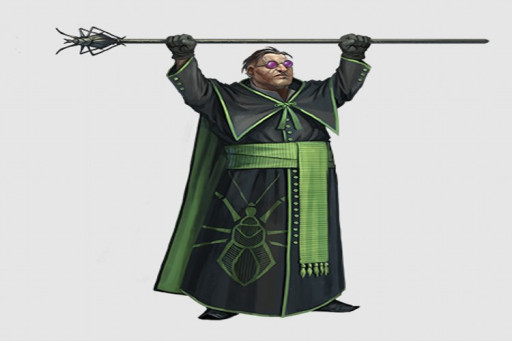
Every weird cult needs a leader. Someone to tell them to drink poison or try to overthrow the local government in the name of their god. But not just anybody can be a cult leader. A cult needs someone charismatic and powerful.
A cult leader has a lot of magic power to back up their claims of godhood. Many use spells like hideous laughter and suggestion to get party members out of the fight. They can also use enthrall to enhance their ability to get more cult members.
The members themselves are where the true power of the cult leader can be. Many of them can and will take blows for the cult leader. The cult leader can also use his enchantment spells and general power of persuasion to get cult members whose deaths will make life more complicated for the party. A defenseless peasant is just as likely to be sucked into a cult as a city watchman and the community won’t take kindly to the mass deaths of either.
Cult Leader Stats
- Level 7
- Perception +14
- Languages Common
- Skills Arcana +13, Cult Lore +19 (applies to the leader's own cult), Deception +16, Diplomacy +14, Intimidation +16, Occultism +17, Society +13
- Str +0, Dex +4, Con +1, Int +4, Wis +3, Cha +5
- Items +1 staff, ceremonial robes, indecipherable book of sigilsAC 23; Fort +12, Ref +15, Will +18
- HP 95
- Protect the Master! (auditory, concentrate, emotion, linguistic, mental, move) Trigger The cult leader is targeted with an attack, and a lower-ranking cultist is adjacent to them; Effect The cult leader orders their cultist to leap in front of the attack. The cultist and cult leader swap places, and the cultist becomes the target of the attack. If the cultist has Fanatical Frenzy or a similar ability, they can activate it as a reaction if they take damage from the triggering attack.
- Speed 25 feet
- Melee staff +13 [+8/+3] (magical, two-hand d8), Damage 1d4+6 bludgeoning
- Occult Spontaneous Spells DC 26, attack +18; 4th dimension door, glibness, outcast's curse, suggestion (3 slots); 3rd enthrall, grim tendrils, haste, mind reading (4 slots); 2nd augury, calm emotions, hideous laughter, touch of idiocy (4 slots); 1st bless, illusory disguise, lock, unseen servant (4 slots); Cantrips (4th) chill touch, daze, detect magic, guidance, shield
- Gather Converts (auditory, concentrate, emotion, linguistic, mental) With a short emotional phrase, the cult leader tries to sway the public to do their bidding. The cult leader tries to convince up to four bystanders in a crowd to either cause a commotion, turn against a person or group, leave the area, protect the cult leader, or calm down. The cult leader attempts a single Deception check against the highest Perception DC among the targets.
- Critical Success The targets believe the lie and act as directed for 1 minute. Additionally, one bystander remains by the cult leader's side, influenced enough to join their sect. All other targets become wise to the cult leader after 1 minute, at which point their attitude toward the leader worsens by one step.
- Success As a critical success, but no bystander joins the sect permanently.
- Critical Failure The crowd is unmoved and unamused, and their attitude toward the cult leader worsens by one step.
2. Gang Leader
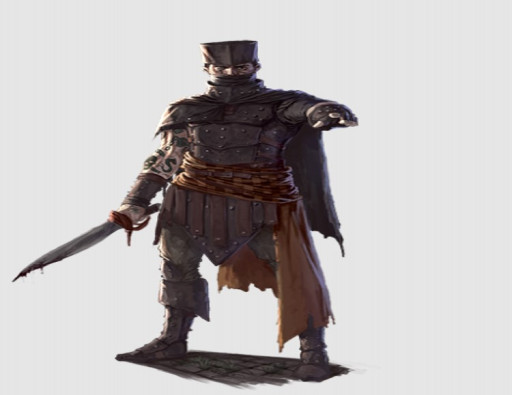
While cult leaders control people by charisma, gang leaders control people by force and intimidation. People don’t rise to the top of gang leadership by being nice. If you’ve disrupted a gang leader’s plans for long enough he may come out to deal with you directly.
A gang leader can be considered an upgraded version of the burglar. He can deny advantage to anyone 7th level or lower. This becomes an even bigger problem for rogues as most of their high-level abilities rely on flanking. They can also use their subordinates to gang up on you.
Gang leaders are strong and have powerful weapons. They also have a lot of gang members on their side. Many of them will be more powerful than your average random gang member. The gang leader will also have sneak attack and other rogue abilities.
Gang Leader Stats
- Level 7
- Perception +14
- Languages Common
- Skills Acrobatics +13, Athletics +13, Deception +15, Intimidation +17, Society +11, Stealth +13, Thievery +15, Underworld Lore +15
- Str +4, Dex +4, Con +2, Int +2, Wis -1, Cha +4
- Items +1 shortsword, minor healing potion, sling (10 bullets), studded leather armor, tanglefoot bag
- AC 26; Fort +13, Ref +17, Will +10
- HP 104
- Deny Advantage The gang leader isn't flat-footed to creatures of 7th level or lower that are hidden, undetected, flanking, or using surprise attack.
- Evasion When the gang leader rolls a success on a Reflex save, they get a critical success instead.
- Surprise Attack On the first round of combat, if the gang leader rolls Deception or Stealth for initiative, creatures who haven't acted are flat-footed to the gang leader.
- Nimble Dodge Trigger The gang leader is targeted with an attack by an attacker they can see; Effect The gang leader gains a +2 circumstance bonus to AC against the triggering attack.
- Speed 30 feet
- Melee shortsword +18 [+14/+10] (agile, magical, versatile S), Damage 1d6+10 piercing
- Ranged sling +18 [+13/+8] (propulsive, range increment 50 feet, reload 1), Damage 1d6+8 bludgeoning
- Brutal Rally (auditory, emotion, linguistic, mental) Trigger The gang leader rolls a critical hit against a creature; Effect All allies that can see the gang leader gain a +1 circumstance bonus to attack rolls until the start of the gang leader's next turn.
- Gang Up Any enemy is flat-footed against the gang leader's melee attacks due to flanking as long as the enemy is within melee reach of both the gang leader and one of the gang leader's allies.
- Quick Draw The gang leader Interacts to draw a weapon, then Strikes with that weapon.
- Sneak Attack The gang leader deals an extra 2d6 precision damage to flat-footed creatures.
1. Pathfinder Venture Captain
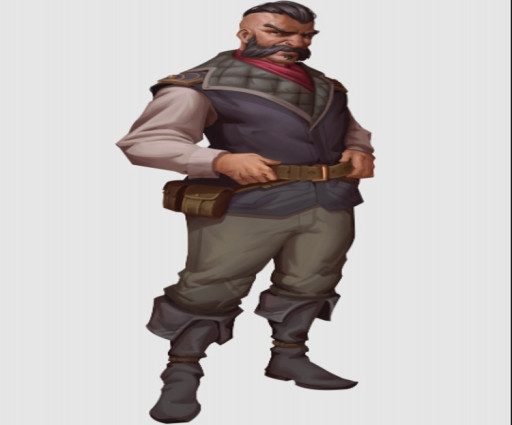
While the Pathfinders are a reasonably good organization, sometimes there are differences of opinion that can get out of hand. Other times, corruption can take hold and a venture captain can put their wealth and glory above the welfare of the people under him. Or he could be tampering with magical artifacts that have a negative effect on their sanity.
Regardless of the reason, a venture captain is not to be underestimated. They get their position by being strong in their main field. Though this stat-line is for a venture captain specializing in physical prowess, you may have to deal with venture captains specializing in magic.
Pathfinder venture captains are intimidating because they know everything about the party. They may have even trained the party and the party may have grown attached. Some role-players may hate this idea and the party may quarrel about this. The venture captain will use this hesitation to their advantage.
Pathfinder Venture Captain Stats:
- Level 11
- Perception +20
- Languages Common
- Skills Alcohol Lore +20, Bardic Lore +16, Diplomacy +21, Occultism +16, Performance +19
- Str +5, Dex +1, Con +3, Int +1, Wis +2, Cha +4
- Items +1 striking warhammer, +1 striking composite longbow, +1 half plate, minor sturdy shield (Hardness 8, HP 64, BT 32), wayfinder
- AC 32 (34 with shield raised); Fort +22 (successes are instead critical successes), Ref +18, Will +19
- HP 195
- Unshakable Anytime the venture-captain gains the frightened condition, reduce its value by 1.
- Attack of Opportunity
- Shield Block
- Speed 20 feet
- Melee warhammer +24 [+19/+14] (magical, shove), Damage 2d8+11 bludgeoning
- Ranged composite longbow +20 [+15/+10] (deadly 1d10, magical, range increment 100 feet, volley 30 feet), Damage 2d8+8 piercing
- Occult Spontaneous Spells DC 27; Cantrips (3rd) detect magic, inspire competence, inspire courage, read aura
- Bardic Lore The venture-captain can Recall Knowledge on any topic using their Bardic Lore skill.
- Paragon's Guard (stance) While the venture-captain is in this stance and wielding a shield, their shield is always raised.
- Weapon Mastery The venture-captain has spent hours training with the hammer. They gain access to the critical specialization effect of all simple and martial hammers.
